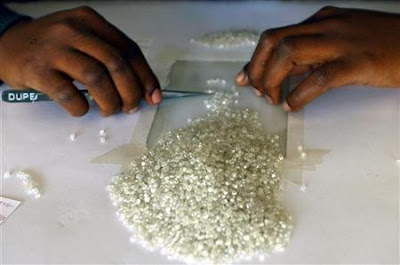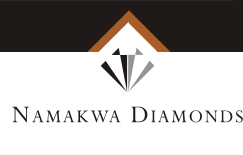
Gaborone, Botswana – What will the Botswana government do with the 10% of run-of-mine rough that it buys from Debswana – the 50:50 De Beers and Botswana government joint venture diamond-mining company – beginning this year?
Will the Botswana government pay the going rate for the rough diamonds or will it receive them at a discount?
Those were the two questions Mining Weekly put to Botswana Minerals Minister Dr Ponatshego Kedikilwe at the media conference which followed the announcement that the ten-year agreement that De Beers had struck with the government provided for an independent sales outlet for the Botswana government, which would begin this year at 10% of Debswana’s run-of-mine production and rise to 15% over a five year period.
Kedikilwe’s response is that the diamond market is changing to the extent that not only the traditional markets of the US, Europe and Japan have to be watched, but also the developing markets of China and India. In addition, there are also new private-sector company participants.
“Because we are no longer in command, to the extent that we were in the earlier years, of how the market works, we now, as government, wish to verify independently how the markets are moving.
“This is no contradiction with our partners (De Beers) and the verification window is precisely what we negotiated, so that we have an independent avenue for ourselves to judge and sniff out what the market looks like in terms of price,” Kedikilwe tells Mining Weekly.
He says the Botswana approach differs totally from the South African approach of legally forcing diamond-mining companies to sell 10% of the diamonds they mine to the State Diamond Trader, which, in turn, makes these available to emerging empowered local diamond cutters and polishers.
Instead, Botswana’s independent diamond sales outlet will be “simply to judge the market” and not to “defile – defile is probably not the word” – the market.
“The market has to be allowed to work independently,” Kedikilwe says.
“De Beers takes 90% and sells it, and we take 10% and sell it. This is a business – no discounts – and all the profits come to both of us at the end of the day,” the Botswana President’s permanent secretary, Eric Molale, explains.
Molale urges Botswana to reciprocate and to “give back to the world” by boosting the country’s productivity.
The evolution of Botswana’s diamond cutting and polishing industry started in the early 1980s with one factory. Following a policy initiative of encouraging downstream beneficiation in 2004, 16 diamond-cutting factories have since been established.
Both the government and De Beers have pledged to continue to nurture the incipient industry into fully integrated operations which do not focus only on cutting and polishing but diversify into new areas such as diamond jewellery manufacturing.
“We must be productive, both in the public and the private sectors, to support the diamond industry. We must, as a matter of urgency, change for the better our work culture and reduce on the culture of entitlement.
“We cannot just have rights. They must be complemented by accountability and responsibility. That’s what we have to give back to the world diamond industry,” Molale says, adding that Botswana needs the diamond revenue to build schools, clinics and roads and to empower its citizens.
Under the new agreement, Botswana will continue to receive 80c out of each dollar of production that Debswana sells and De Beers 20c.
Anglo American CEO Cynthia Carroll, who was present at the signing, says that De Beers, which is 45% Anglo-owned, remains core.
De Beers is currently performing well and shareholders are looking to new De Beers CEO Philippe Mellier to add value during a time of uncertainty in global economics.
Despite fiscal tightness globally, Mellier reports that demand for diamonds remains “very strong”, with a likely build-up towards the Christmas season and the Chinese New Year and the expectation that diamond consumption in 2011 will exceed that of 2010.
While the US remains the largest con-sumer of diamonds, last year China’s offtake increased by 25% and India’s by 31%.
De Beers expects China, India and the Gulf collectively to match US market share for diamonds by 2015. At the same time, demand for diamonds has increased significantly across most major markets, as consumers continue to focus on fewer but better things during uncertain times.
Move From London
Debswana has been selling its diamonds exclusively to De Beers, which, in turn, shipped the diamonds to London for aggregation and selling to its customers known as sightholders.
Now the new agreement, backdated to January 1, stipulates that De Beers must relocate its ‘sights’ and sales operations – including professionals, skills, equipment and technology – from London to Gaborone by the end of 2013.
From its new base in Botswana, the Diamond Trading Company will aggregate – parcel similar diamonds together – production from De Beers’ mines and its joint venture operations worldwide, and sell to international sightholders.
De Beers chairperson Nicky Oppenheimer says that initial consultation has begun with De Beers staff in London on the transfer of London activities to Gaborone by the end of 2013.
“It’s not going to be easy, but we are committed to it,” Oppenheimer adds.
De Beers director of strategy and new business Bruce Cleaver says the transfer process is complex, which is why a timescale has been agreed to ensure that the shift can be done in a completely seamless way, so that there is no negative impact on clients receiving regular supplies from De Beers.
“We would expect a combination of people migrating from London and, broadly speaking, we expect the numbers of people to remain constant,” Cleaver adds.
Others Looking On
De Beers has the capacity to produce 45-million carats a year and Molale expects $6-billion worth of diamonds to be traded a year in Botswana, including diamonds from Canada, South Africa, Namibia and the other countries where De Beers is involved.
On a visit to Btoswana, Democratic Republic of Congo (DRC) President Joseph Kabila spoke of the possibility of DRC diamonds being aggregated and traded in Botswana, where Lesotho diamonds are already sent and which is likely to attract the diamonds of all Kimberley Process-certified African countries in time.
“Before diamonds come here, we would want to ensure that they are clean diamonds,” Molale comments to Mining Weekly.
De Beers is no longer the only company mining diamonds in Botswana and has been joined by far smaller companies like Lucara, Firestone and others, which have begun auctioning diamonds in Botswana.
Oppenheimer sees the latest agreement with the Botswana government as being good for Africa.
“The potential’s there. One’s got to make the exciting things happen now. That’s going to require input from all sides. It’s going to require input from the government, but also from sightholders who are getting goods and working here. So the opportunity is there. Now it’s got to be grasped,” Oppenheimer comments to Mining Weekly.
On diamond exploration, Oppenheimer comments that diamond mines are extra- ordinarily difficult to find.
“You can find kimberlites, but can you find a kimberlite that’s economic and, even better, can you find a kimberlite of the nature of Venetia, Orapa and Jwaneng? They are very few and far between,” he says.
De Beers does, however, have a new diamond project in a permitting phase in Canada that Cleaver says will eventuate in a mine and it has some promising finds in Angola.
While De Beers of the past has always had a competition-authority problem in acquiring other diamond assets because of its large market share, its proportion of the world’s production is now dramatically less than it used to be and the lower it becomes, the greater the acquisition opportunity.
“We are certainly alive to acquisitions,” Cleaver tells Mining Weekly.
The world’s leading rough diamond com- pany, De Beers, which was established in South Africa in 1888, currently operates in 20 countries across six continents, employing more than 16 000 people.
Botswana’s Vision
How is the ten-year agreement expected to improve the Botswana economy in the coming years? Could Gaborone become a second Antwerp?
Kedikilwe’s response to these Mining Weekly questions is that he hopes Gaborone develops into a city better than Antwerp.
Botswana’s last beneficiation convention attracted high-level diamond leaders.
“We want to be the diamond centre of the world and we would like to turn the holes that diamond mining has punched into our ground into tourist attractions. We would like to prove to posterity that we did well with the mystique stones,” says Kedikilwe
The country now has the elaborate Diamond Trading Company (DTC) Botswana sorting and valuing centre, the 570-employee Diamond Technology Park, which is being expanded, and upgraded infrastructurally.
Because of the diamond value chain’s considerable gestation period, financial muscle is needed in order to sustain.
The Diamond Technology Park’s tenants already include ABM Amro Bank, the Gemological Institute of America, diamond cutter and polisher Safdico – whose MD is Shanee Orbach – which developed the park, Steinmetz and jeweller manufacturers including Shrenuj, which is listed in Bombay.
Kedikilwe has been on a roadshow to Antwerp in a bid to attract companies to Botswana that have the skills to mount diamonds on items like watches, as well as financial institutions.
The Minerals Minister is also intent on developing local skills to deal with small diamonds and to lower the cost environment needed to compete in the arena of small diamonds.
Safdico Botswana CEO Rutang Moses says the 124-employee company specialises in top-end diamonds and is promoting Botswana as a training centre.
“We’ve built a factory that has the com- petence, technology and skills to cut and polish big stones,” Moses adds.
A delegation of Australian diamond jewellers are scheduled to visit the Jwaneng diamond mine, in Botswana, in October, Jeweller Magazine reports.
Tolkowsky Diamonds has reportedly organised the junket to the world’s biggest diamond mine by value, on behalf of Australia’s Nationwide Jewellers.
In addition to a visit to the mine, the itinerary includes a stop at the DCT’s rough diamond sorting facility and Tolkowsky’s own diamond-cutting factory, which produces the Hearts and Arrows design.
In a press release, Nationwide Jewellers director Barry Jackson called the trip “a unique opportunity to follow the path of diamonds”.
The latest agreement, and the tangible outcomes it is expected to deliver, should thus enable Botswana to achieve its aspiration of being a major diamond centre engaged in all aspects of the diamond business, 44 years after De Beers’ geologists first discovered diamonds near what is today Botswana’s Orapa diamond mine.






























